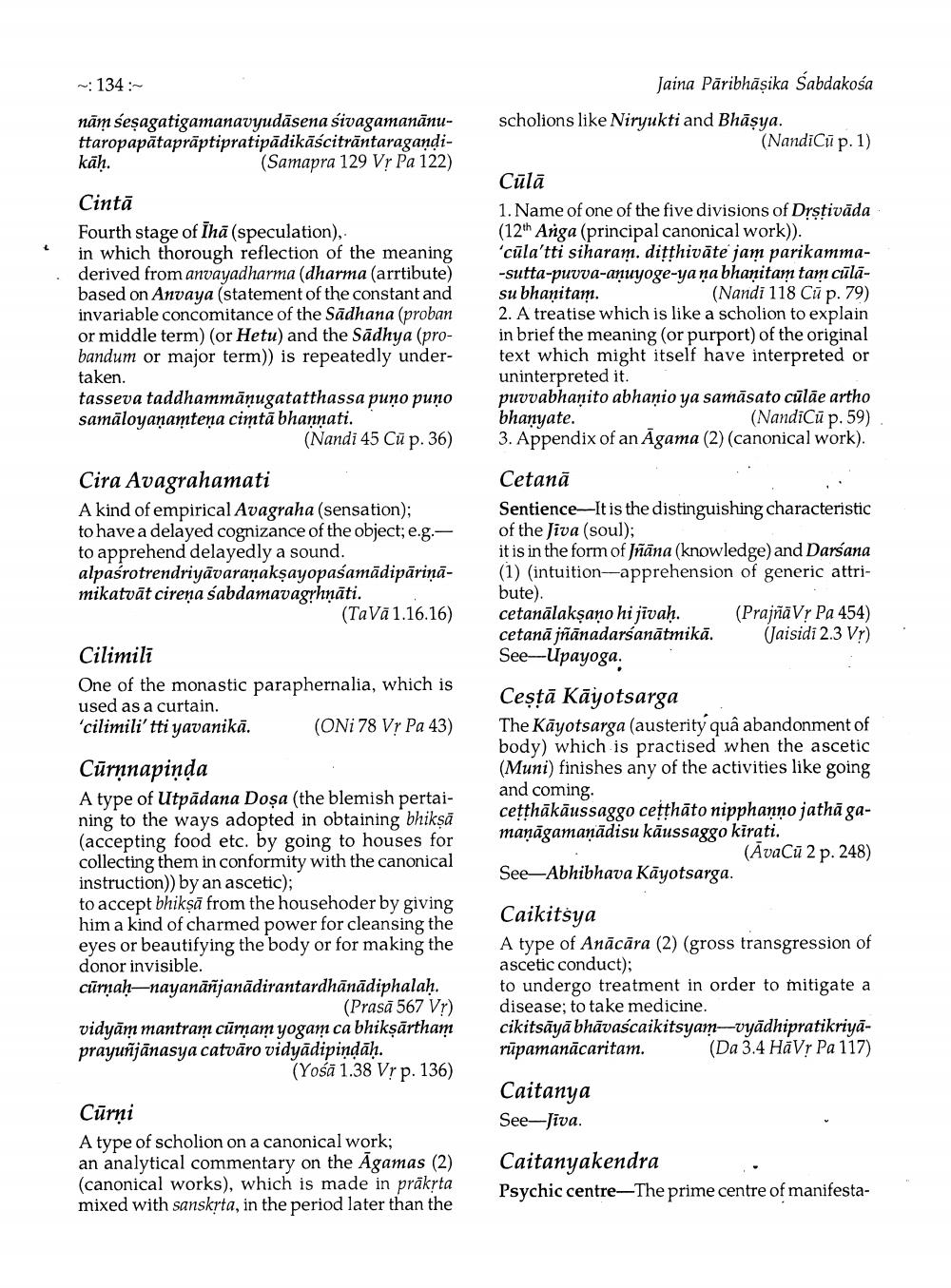________________
134:
nām seşagatigamanavyudāsena sivagamanānuttaropapātaprāptipratipādikāścitrāntaragandikāḥ.
(Samapra 129 VỊ Pa 122)
Jaina Pāribhāșika Sabdakosa scholions like Niryukti and Bhāşya.
(NandiCū p. 1)
Cintā Fourth stage of Ihā (speculation), in which thorough reflection of the meaning derived from anvayadharma (dharma (arrtibute) based on Anvaya (statement of the constant and invariable concomitance of the Sādhana (proban or middle term) (or Hetu) and the Sadhya (probandum or major term)) is repeatedly undertaken. tasseva taddhammāņugatatthassa puno puno samāloyaņamteņa cimtā bhannati.
(Nandi 45 Cū p. 36)
Cülā 1. Name of one of the five divisions of Drstivāda (12th Arga (principal canonical work)). 'cūla'tti siharam. ditthivāte jam parikamma-sutta-puvva-aņuyoge-yanabhanitam tam cūlāsu bhaạitam.
(Nandi 118 Cū p. 79) 2. A treatise which is like a scholion to explain in brief the meaning (or purport) of the original text which might itself have interpreted or uninterpreted it. puvvabhanito abhaņio ya samāsato cūlāe artho bhanyate.
(NandiCū p. 59) 3. Appendix of an Agama (2) (canonical work).
Cira Avagrahamati A kind of empirical Avagraha (sensation); to have a delayed cognizance of the object; e.g.to apprehend delayedly a sound. alpasrotrendriyāvaranakşayopasamādipāriņāmikatvāt cireņa sabdamavagyhnäti.
(Tavā 1.16.16)
Cetan8 Sentience-It is the distinguishing characteristic of the Jiva (soul); it is in the form of Jñāna (knowledge) and Darsana (1) (intuition-apprehension of generic attribute) cetanalaksano hi jioah. (PrajñāV Pa 454) cetanā jñānadarśanātmikā. (Jaisidi 2.3 Vr) See-Upayoga,
Cilimili One of the monastic paraphernalia, which is used as a curtain. 'cilimili'tti yavanikā. (ONi 78 Vr Pa 43)
Ceștā Kāyotsarga The Kāyotsarga (austerity quâ abandonment of body) which is practised when the ascetic (Muni) finishes any of the activities like going and coming cetthākāussaggo cetthāto nipphanno jathā gamaņāgamaņādisu kāussaggo kirati.
(AvaCu 2 p. 248) See-Abhibhava Kāyotsarga.
Cūrạnapiņda A type of Utpādana Dosa (the blemish pertaining to the ways adopted in obtaining bhikṣā (accepting food etc. by going to houses for collecting them in conformity with the canonical instruction)) by an ascetic); to accept bhikṣā from the househoder by giving him a kind of charmed power for cleansing the eyes or beautifying the body or for making the donor invisible. cürnah—nayanāñjanādirantardhānādiphalah.
(Prasā 567 Vr) vidyām mantram cūrņam yogam ca bhikṣārtham prayuñjānasya catvāro vidyādipindāḥ.
(Yos 1.38 Vr p. 136)
Caikitsya A type of Anācāra (2) (gross transgression of ascetic conduct); to undergo treatment in order to mitigate a disease; to take medicine. cikitsāyā bhāvascaikitsyam—vyādhipratikriyarūpamanācaritam. (Da 3.4 HāVr Pa 117)
Caitanya See-Jiva.
Cūrni A type of scholion on a canonical work; an analytical commentary on the Agamas (2) (canonical works), which is made in präkrta mixed with sanskrta, in the period later than the
Caitanyakendra Psychic centre-The prime centre of manifesta




